Japan
Wood Products Prices
Dollar Exchange Rates of 10th
Mar
2024
Japan Yen 148.46
Reports From Japan
Trend in wage negotiations
key in decisions on
interest rates
Every spring unions and management in Japan hold talks
(known as shunto) to agree wages ahead of the April fiscal
year. Economists are closely monitoring this years’
negotiations because the outcome will influence the Bank
of Japan (BoJ) monetary policy. The BoJ governor has
said that “a clear trend of wage increases is key to meeting
its inflation target which will give the Bank the confidence
to adjust its policy on interest rates.
The largest labour confederation has announced record
pay increases, signaling a break from the deflationary
spiral that held down growth in the so-called "lost decades.
Driving the wage increases is the growing labour shortage
in many sectors along with rising prices of everyday items
made worse by a weak yen.
However, only about 16% of workers in Japan are union
members and, with small companies accounting for
around 70% of employment, the ability of these companies
to raise wages depends heavily on whether they can pass
on costs to customers, many of which are the big
enterprises who will fight to keep production costs down.
See:
https://www.cnbc.com/2024/03/14/japan-2024-shunto-spring-wage-negotiations.html
Third quarter surge in capital spending
Ministry of Finance data shows capital spending by
Japanese companies surged in the October-December
quarter from a year earlier which was interpreted to
suggest the state of the Japanese economy was not as weak
as often portrayed.
Investment by financial sectors in building factories and
adding equipment in the same quarter was a record.
Japanese companies increased investment for the 11th
straight quarter suggesting an underlying strength in
demand.
Manufacturers increased investment by just over 20% to
boost output capacity marking the 11th straight quarter of
expansion. Investment by non-manufacturers rose 14%,
marking the sixth straight quarterly increase.
However, a study by the Cabinet Office shows Japanese
companies, mainly the small and medium companies, are
using some of the oldest equipment among Group of
Seven economies and indicated this needs to be addressed
if productivity is to improve. Japan was ranked 30th in
labour productivity among the 38 Organization for
Economic Cooperation Development members in a 2022
survey.
See:https://www.japantimes.co.jp/business/2024/01/08/japan-labor-productivity-ranking/
and
https://asia.nikkei.com/Business/Business-trends/Japanese-companies-stuck-with-second-oldest-equipment-in-G7
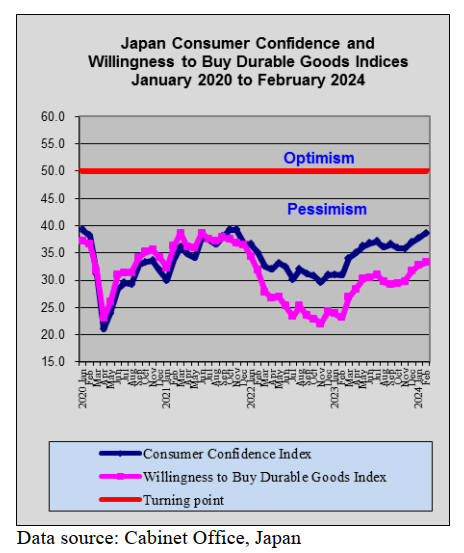
Another home builder eyes the US market
Japanese homebuilder Daiwa House Industry Group is
looking to launch a business in the US to make
prefabricated panels for residential homes. The company
believes building a factory in the country can lead to lower
construction costs over the medium to long term. This
approach to market diversification is different from that of
the Sekisui House approach which is to acquire US
companies as a way to penetrate the US market.
See:
https://asia.nikkei.com/Business/Construction/U.S.-housing-market-becomes-battleground-for-rival-Japan-homebuilders

Shift in Bank of Japan rate policy expected this
month
When the Bank of Japan (BoJ) will begin exiting its policy
of negative interest rates which was introduced to lift the
country out of deflation is now hotly debated with most
analysts expecting a change this year. For the first time in
a month the yen strengthened to 147 against the US dollar
in early March as a wave of yen buying was sparked by
comments from a BoJ official.
See:
https://www.reuters.com/markets/asia/boj-leaning-toward-exiting-negative-rates-march-sources-2024-03-08/
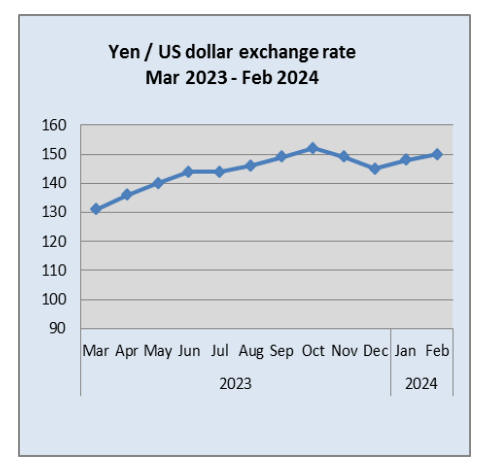
Forestry and timber industries in need of foreign
workers
It appears a decision will be made soon by the government
to sharply increase the number of foreign nationals it
accepts under its Skilled Worker Visa scheme. This
change in policy is in response to the acute labour shortage
in the country. The domestic media reports that the
government is considering adding the road transportation,
railways, forestry and timber industries to those within
scope for the skilled worker visa system.
See:
https://asia.nikkei.com/Spotlight/Japan-immigration/Japan-to-double-cap-on-skilled-foreign-workers-from-fiscal-2024
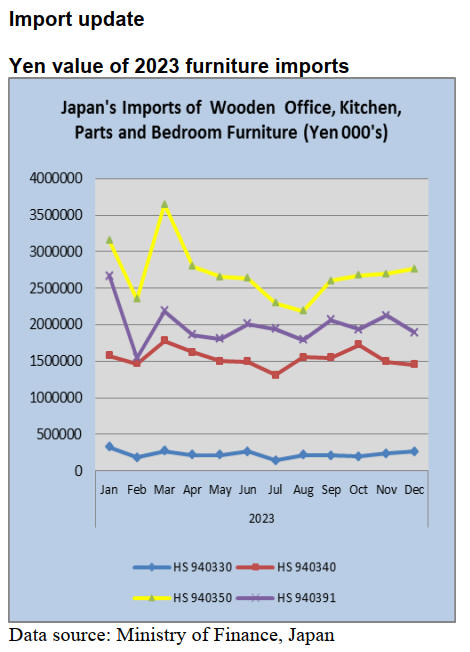
December wooden office furniture imports (HS
940330)
In December last year shipments of wooden office
furniture from China accounted for over 80% of all
imports of HS940330 marking a sharp jump in the value
of shipments compared to a month earlier.
Malaysia was the second largest shipper of wooden
office
furniture in December and accounted for around 5% of
arrivals in Japan. The other significant shipper in
December was the US at around 3% of the total value of
arrivals but this was down slightly compared to
November.
Year on year, the value of December 2023 imports of
wooden office furniture was down 15%, however,
compared to November 2023 there was a 10% increase in
the value of imports.

December kitchen furniture imports (HS 940340)
Shippers of wooden kitchen furniture in just two countries
accounted for over 80% of the value of Japan’s imports of
wooden kitchen furniture; the Philippines (45%) and
Vietnam (36%). Shippers in China contributed a further
7% and there was a slight rise in shipments from Germany
to account for a further 4% of total arrivals.
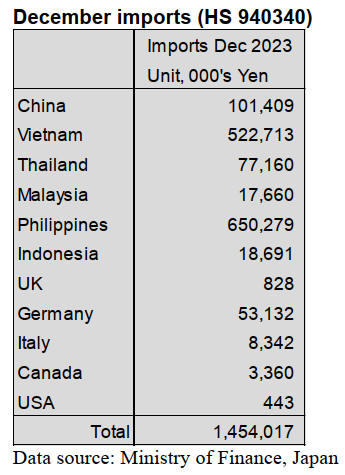
The value of imports of HS940340 in December 2023 was
unchanged when compared to a year earlier and also
largely unchanged when compared to a month earlier.
December wooden bedroom furniture imports (HS
940350)
Beginning September 2023 there was a recovery in the
value of wooden bedroom furniture imports to Japan. The
upward trend continued through October and November
but the up-swing slowed in December when month on
month the value of imports was almost unchanged.
However, Compared to a year earlier, December 2023
imports were up around 3%.
Shippers in Vietnam do well in Japan with shipments of
HS940340 and HS940350. In December shippers in
Vietnam accounted for around 35% of the value of imports
to Japan of HS940350 but, as in previous months, the top
shipper was China with close to 60% of the total value of
December arrivals. Other major shipments were from
Malaysia at 3-4%, Thailand, Indonesia as well as small
amounts from Italy and Poland.
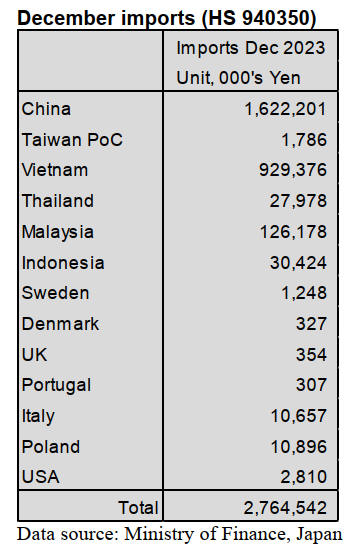
December wooden furniture parts imports (HS
940391)
Japan’s imports of of wooden furniture parts are very
diverse, much more so than with imports of assembled
furniture. In December shippers in China topped the list of
shippers in terms of the value of exports of wooden
furniture parts to Japan, accounting for just over 45% of
the total December import value. China was followed by
Indonesia, shipping 20% of December imports, Vietnam
(13%) and Malaysia (9%).
All four top shippers witnessed a decline in the value of
December shipments and for the month there was an
overall 11% decline in the value of imports. There was
also a 13% decline in year on year imports in December.
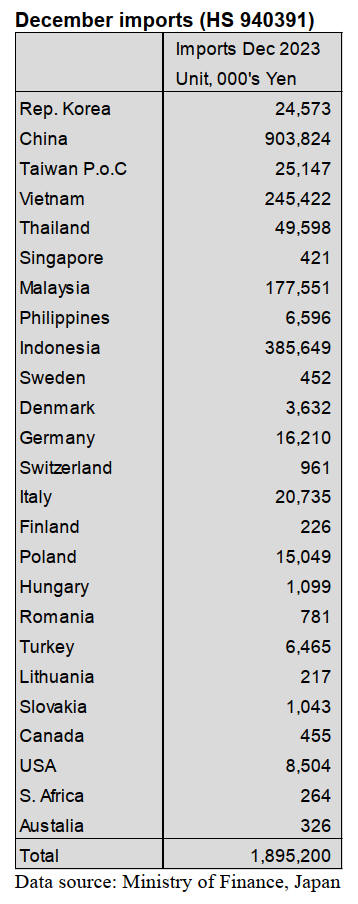
Trade news from the Japan Lumber Reports (JLR)
The Japan Lumber Reports (JLR), a subscription trade
journal published every two weeks in English, is
generously allowing the ITTO Tropical Timber Market
Report to reproduce news on the Japanese market
precisely as it appears in the JLR.
For the JLR report please see:
https://jfpj.jp/japan_lumber_reports/
Wood export in 2023
Lumber export in 2023 is 135,064 cbms, 23.5 % less than
2022. This is straight two years decreasing. On the other
hand, log export in 2023 is 1,595,406 cbms, 20.5 % more
than last year. This is for the first time in two years to rise
and this is the first time to exceed 1,500,000 cbms ever.
There is a huge influence of sluggish demand for lumber
in the world. The weak yen does not make a good result
for exporting lumber. Many logs are exported to China.
Total wood exports were 50.4 billion yen, 4.2 % down
from the previous year. This is for the first time in four
years to decline but this is straight two years exceeding 50
billion yen.
Log export to China is 1,416,214 cbms, 26.6 % up
from
2022. This result exceeds the result in 2021, which was
1,218,775 cbms and was the highest record at that time.
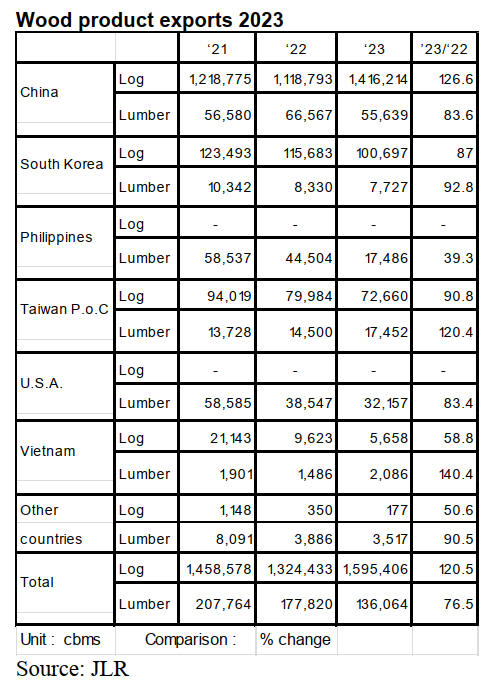
The yen was 130 yen against the dollar at the
beginning of
2023 and the yen continued depreciating through the year.
The yen depreciated to 150 yen against the dollar in
November, 2023. The freight for a bulk ship to China was
$45,000 – 50,000. The cost of collecting cedar logs had
been 10,000 – 10,500 yen, delivered per cbm through the
year. The selling price of cedar log at the beginning of
2023 was $115, C&F per cbm and the selling price
declined to $110, C&F per cbm in the middle of the year.
However, other cost also declined and Japanese exporters’
motivation to export logs did not decline. Exporting logs
to South Korea, Taiwan and Vietnam decline in 2023.
Lumber export to the U.S.A. in 2023 is 32,157 cbms, 16.6
% down from 2022.
This is straight two years falling. This is 45.1 % down
from 2021, when the lumber export was 58,537 cbms. A
lot of backboards and scraps of precutting lumber are
exported to China. The unit price of exporting cedar
lumber is 20,000 yen, FOB per cbm.
Domestic logs and lumber
Demand for domestic lumber has been very sluggish
through the nation. Therefore, the price of structural
lumber plunged in February, 2024.
3 m x 105 mm KD cedar post in Kanto region is around
57,000 yen, delivered per cbm and this is around 3,000
yen lower than the previous month. In the northern part of
Kanto region, it is 60,000 yen.
The movement of 4 m x 105 mm KD cypress sill is
still
slow and the price is 77,000 – 80,000 yen. This is 5,000
yen lower than last month.
The price of KD whitewood stud is around 70,000 –
75,000 yen, delivered per cbm and the price will rise in the
future. 3 m x 30 x 105 mm KD cedar stud is around
60,000 yen, delivered.
The price of domestic log has been no changed because
the lumber market is dull and there are not enough logs
due to snowfall or rainfall. Cedar log for posts is 16,000
yen, delivered per cbm in the northern part of Kanto
region. It is 15,500 yen, delivered per cbm in Kyushu
region.
The price of cypress log for post in Tokai region is 22,000
yen, delivered per cbm and it is 17,000 yen, delivered per
cbm in the northern part of Kanto region. Cedar log is
1,000 – 2,000 yen lower than the previous year and
cypress log is 1,000 – 3,000 yen lower than the previous
year.
The price of cedar log plunged in the northern part of
Kanto region last spring so log companies are very
cautious for the plummet this year.
Plywood
Movement of domestic softwood plywood has been
sluggish since the end of January, 2024. Domestic
plywood manufacturers keep reducing production but
demand and supply for softwood plywood are lower than.
production in February. Some reasons are a decrease in the
new starts, a decrease in orders to precutting plants and a
decrease in demand and supply in distribution business.
12 mm 3 x 6 structural softwood plywood is around 1,350
yen, delivered per sheet, in the Greater Tokyo
Metropolitan area. This is around 100 yen lower than
January and February. However, the price of 12 3 x 6
structural softwood plywood in Kyushu region and
Hokkaido Prefecture is higher than other areas.
Since the log price and the distribution cost have been
increasing, a sense of urgency in the plywood business has
increased because the price has been falling.
Also, movement of South Sea plywood has been sluggish.
There is not tight supply so far even though the arrival
volume of South Sea plywood has been decreasing since
last year.
The price of South Sea plywood is unchanged from the
previous month. 2.5 mm plywood is 780 yen, delivered
per sheet. 4 mm plywood is 1,000 yen, delivered per sheet.
5.5 mm plywood is 1,200 yen, delivered per sheet. 12 mm
3 x 6 painted plywood for concrete form is 1,990 – 2,000
yen, delivered per sheet. Structural plywood is 1,800 yen,
delivered per sheet.
Shippers in Malaysia and Indonesia still expect to raise the
price but Japanese buyers hesitate to purchase a lot of
South Sea plywood so the price of South Sea plywood is
unchanged.
2.4 mm 3 x 6 is around $950, C&F per cbm. 3.7 mm is
US$880, C&F per cbm. 5.2 mm is US$850, C&F per cbm.
12
3 x 6 painted plywood for concrete form is $670 – 680,
C&F per cbm. Form plywood is around US$580, C&F per
cbm. Structural plywood is US$560– 570, C&F per cbm.
Imported wood fuel in 2023
Import of wood pellet and PKS both increased in 2023.
Total volume of wood pellet and PKS is 8,600,000 tonnes.
Wood pellet import in 2023 is 5,810,000 tonnes, 31.9 %
more than 2022. Vietnamese wood pellet is 2,610,000
tonnes, 9.1 % up from the previous year.
Canadian wood pellet is 1,580,000 tonnes, 16.5 % more
than last year. American wood pellet is 1,260,000 tonnes,
316.8 % up. However, Australian wood pellet is 49,000
tonnes, 16.7 % less than 2022.
The reason for the increase is that many huge wooden
biomass power plants have been established last year. PKS
import in 2023 is 2,880,000 tonnes, 0.4 % up from 2022.
Indonesian PKS is 2,240,000 tonnes a 1.5 % increase from
last year. Malaysian PKS is 631,000 tonnes, 4.5 % down
from the previous year.
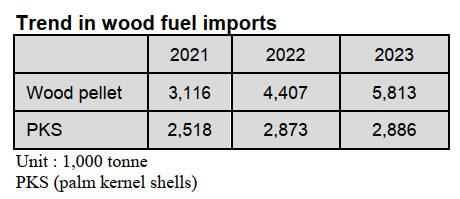
|